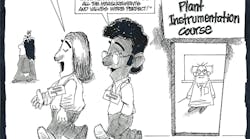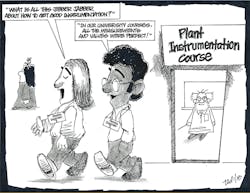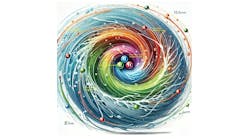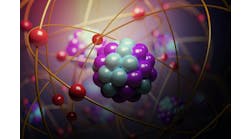This Control Talk column appeared in the January 2019 print edition of Control. To read more Control Talk columns click here or read the Control Talk blog here.
I was fortunate to have spent the first eight years of my career as an I&E engineer designing, installing, checking out, commissioning and starting up over half a dozen production units. Even after moving into a technology role where the emphasis was on the synergy between dynamic modeling and control, a lot of my focus remained on field instrumentation. I ventured into DCS configuration, research and development. My experimentation with fuzzy logic control and neural networks confirmed that the control solutions given good instrumentation and dynamic models use PID or model predictive control (MPC), as proven by history.
To help understand the critical role of instrumentation, here is a meeting of the minds of “PID Greg” and “I&E Greg” that addresses many of the important issues that come up in temperature systems where the primary goal is maximization of process performance instead of minimization of instrumentation cost. Often, project goals are shortsighted, not realizing that the extra cost of better instrumentation is trivial compared to the decrease in lifecycle costs and the increase in plant profitability.
PID Greg: Good temperature control is often the key to process efficiency and capacity. For chemical and biological reactor control, tight temperature control is needed to maximize product quality and quantity. Chemical reaction rate is often an exponential function of temperature, as seen in the Arrhenius Equation. Side reactors can also occur for deviations from the best temperature. High temperatures can lead to unsafe runaway exothermic reactions. For biological processes, cell growth and product formation is extremely dependent on achieving and maintaining the best temperature. High temperatures can cause dramatic increases in cell death rates. Excellent temperature control is essential to the performance of columns, crystallizers, dryers, evaporators, furnaces, kilns and many other unit operations. The best temperature measurement reliability, repeatability, resolution and response are critical for a PID to minimize the control errors for load and setpoint changes. Assuming the transmitter is properly calibrated for the sensor used, minimizing drift is necessary for achieving the best setpoint.
How can we achieve a temperature measurement with best reliability, repeatability, resolution and response, and least drift?
I&E Greg: While the cost of an RTD may be slightly greater than a TC, the savings in maintenance and better process performance from much less drift, better repeatability and higher resolution far exceeds the incremental cost. Also, the savings from less wiring, calibration and prevention of noise and mistakes is significantly greater than the additional cost of a preassembled thermowell and sensing element with integral mounted transmitter calibrated by the supplier. If the temperature of the line is high, a lagging thermowell or extension of the pipe nipple may prevent a temperature effect on transmitter. If the transmitter must be mounted separately for accessibility, the location should be as close as possible to the sensor. Class 1 special grade extension wire should be used for TCs and four-wire RTD leads. “Sensor matching” should be done for RTDs, where the four constants of a Callendar-Van-Dusen (CVD) equation are provided by the sensor supplier and entered into the transmitter. Even though thermowells may withstand vibration, potential damage can occur to RTDs. For temperatures above 400 oC or significant vibration, deterioration of RTD accuracy and life may make a TC a better choice. For temperatures above 850 oC, a TC must be used. The TC should be ungrounded and its material selected to meet temperature range requirements to maximize life and minimize drift and noise.
The repeatability, accuracy and signal strength are two orders of magnitude better for an RTD compared to a TC. The 1-20 °C drift per year of a TC is of particular concern for biological and chemical reactors and distillation control because of the profound effect on product quality from control at the wrong operating point. The already exceptional accuracy for a Class A RTD of 0.1 °C can be improved to 0.02 °C by “sensor matching.” The main limit to accuracy of an RTD is the transmitter and wiring. The use of four extension lead wires for an RTD enables total compensation that accounts for the inevitable uncertainty in resistance of lead wires. Standard lead wires have a tolerance of 10% in resistance. For 500 feet of 20-gauge lead wire, the error could be as large as 26 °C for a two-wire RTD and 2.6 °C for a three-wire RTD. The “best practice” is to use a four-wire RTD unless the transmitter is located close to the sensor, preferably on the sensor. The transmitter accuracy of about 0.1 °C can be improved by a single dry block calibration since transmitter and sensor drift is negligible.
The air in the annular clearance between the thermowell interior wall and sensor sheath is the dominant source of slowness in the temperature response. For the same reason, a spring-loaded, sheathed TC or RTD should be used to ensure the tip of the sheath is touching the bottom of the thermowell. The next greatest cause of slowness is the rate of heat transfer between the fluid and thermowell. Gases have a much smaller rate and hence slower response.
Liquid velocity doesn’t seem to appreciably slow down the response until the velocity drops below 0.1 feet per second (fps). Velocities below 5 fps can cause fouling and a consequential huge increase in the thermowell time constants. Thermowell metal mass has a lesser effect but it’s still greater than sensor type. A stepped thermowell that minimizes the metal mass near the tip has a faster response, as do higher-thermal-conductivity metals. Using ceramic protection tubes rather than metal thermowells can cause an exceptionally slow response.
Stepped thermowells should be specified with an insertion length greater than five times the tip diameter (L/D > 5) to minimize error from heat exchange between the thermowell tip and pipe or equipment connection from thermal conduction, and an insertion length less than 20 times the tip diameter (L/D < 20) to minimize vibration from wake frequencies. Calculations by suppliers on length should be done to confirm that heat conduction error and vibration damage is not a problem. Stepped thermowells reduce the error and damage, and provide a faster response.
Thermowell material must provide corrosion resistance and if possible, high thermal conductivity to minimize conduction error or response time, whichever is more important. The tapered tip of the thermowell must be close to the center line of pipe, and the tapered portion of the thermowell completely past the equipment wall including any baffles. For columns, the location should be used that shows the largest and most symmetrical change in temperature for an increase and decrease in manipulated flow. Simulations can help find this, but it is wise to have several connections to confirm the best location by field tests. The tip of the thermowell must see the liquid, which may require a longer extension length or mounting on the opposite side of the down-comer to avoid the tip being in the vapor phase due the drop in level at the down-comer.
The best location for a thermowell for small-diameter pipelines (e.g., less than 12 in.) is in a pipe elbow facing upstream to maximize insertion length in the center of the pipe. If abrasion from solids is an issue, the thermowell can be installed in the elbow facing downstream but a greater length is needed to reduce noise from swirling. If a pipe is half filled, the installation should ensure the narrowed diameter of the stepped thermowell is in liquid and not vapor.
The location of a thermowell must be sufficiently downstream of joining streams or a heat exchanger tube side outlet to enable remixing of the streams. The location must not be too far downstream due to the increase in transportation delay, which is the residence time for plug flow (the pipe volume between the outlet or junction and sensor location divided by the pipe flow, or volume/flow). For a length that is 25 times the pipe diameter (L/D = 25), the increase in loop dead time of a few seconds is not as detrimental as a poor signal-to-noise ratio from poor uniformity. For desuperheaters, to prevent water droplets from creating noise, the thermowell must provide a residence time that is greater 0.3 seconds, which for high gas velocities can be much greater than the distance required for liquid heat exchangers.
PID Greg: If you want a comprehensive, concise view of how to achieve the best measurement and control, look for the McGraw-Hill Handbook, “Process/Industrial Instruments and Controls, Sixth Edition” due out in early 2019. The handbook covers the design, installation, calibration, commissioning and maintenance of every part of an automation system, concluding with a list of best practices for each of the hundred sections, resulting in over a thousand best practices. See the Control feature article, “Best practices for PID” for another glimpse of what the handbook offers.
10. Dead time is so boring!
9. Do we have time to measure this time constant?
8. What is to be gained by waiting to see the final resting value of PID output?
7. Why do we need PIDs when all we need to do is set the flows per the PFD?
6. Do we really have to let a PID set the process and utility flows?
5. Can't I just set the best flows per process design?
4. I like integral action because it continually works to match PV and SP to the last decimal point!
3. Since process dynamics are a moving target, can we make it into a video game?
2. Why are the process control specialists all old people?
1. Good grief, is there really nothing better for a fast single loop than a 100-year-old PID?







